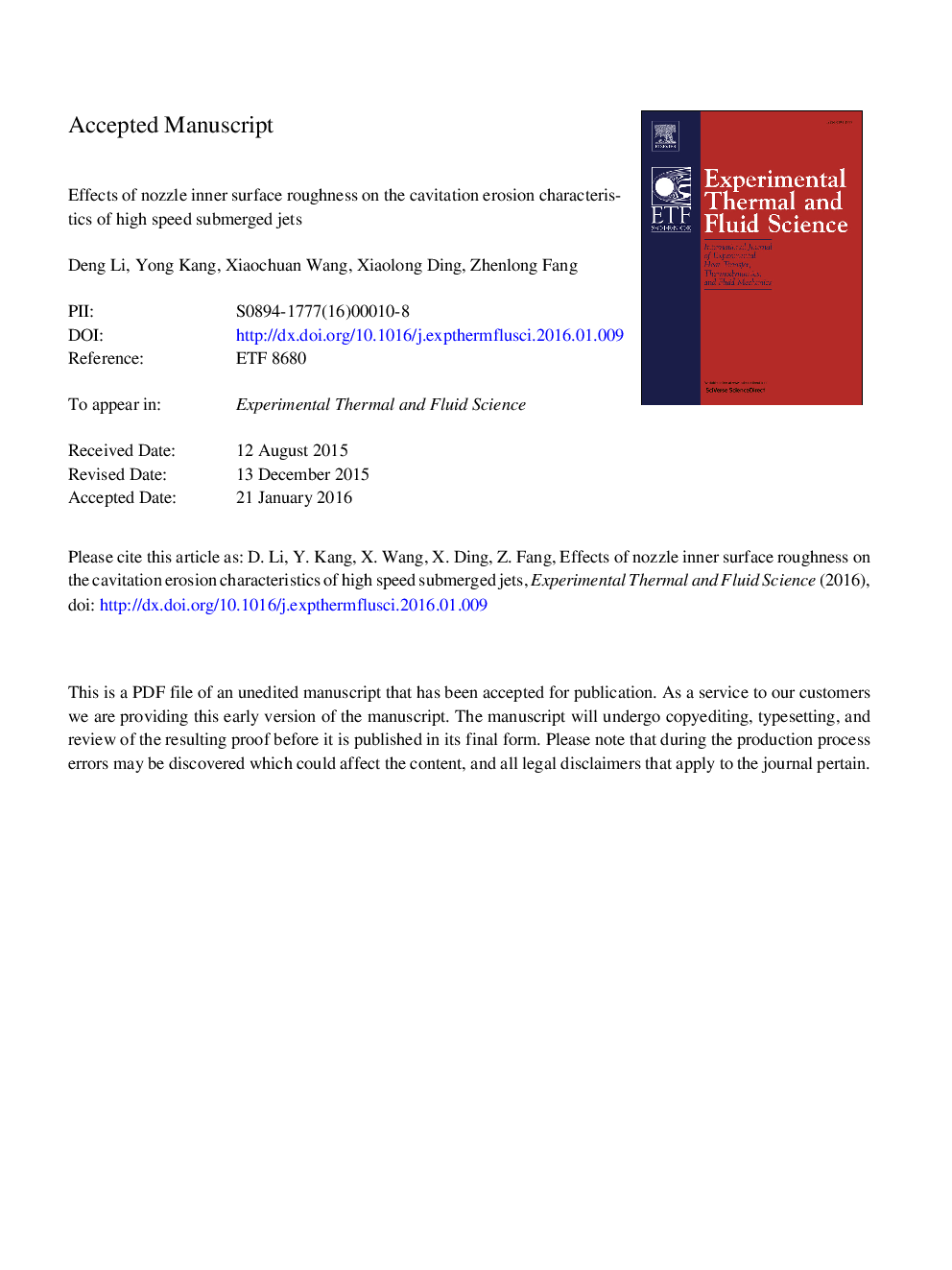| کد مقاله | کد نشریه | سال انتشار | مقاله انگلیسی | نسخه تمام متن |
|---|---|---|---|---|
| 651217 | 1457402 | 2016 | 20 صفحه PDF | دانلود رایگان |
عنوان انگلیسی مقاله ISI
Effects of nozzle inner surface roughness on the cavitation erosion characteristics of high speed submerged jets
ترجمه فارسی عنوان
اثر ناهمواری سطح درون نازل بر ویژگی های فرسایش حفره ای جت های با سرعت بالا غوطه ور است
دانلود مقاله + سفارش ترجمه
دانلود مقاله ISI انگلیسی
رایگان برای ایرانیان
موضوعات مرتبط
مهندسی و علوم پایه
مهندسی شیمی
جریان سیال و فرایندهای انتقال
چکیده انگلیسی
Cavitating jet is now being widely used in a variety of situations due to its strong aggressive erosion ability. In order to push the erosion capability to a maximum, the effects of nozzle inner surface roughness on the cavitation erosion characteristics of submerged cavitating jets were experimentally investigated for the first time with respect to aggressive erosion intensity and efficiency. By impinging the submerged jets on specimens of pure aluminum (1070A) using six organ-pipe cavitating nozzles of different surface roughness values (0.8 μm , 1.6 μm, 3.2 μm, 6.3 μm, 12.5 μm, and 25 μm), the mass loss and specific energy consumption at various inlet pressures and standoff distances were measured and analyzed. And the macroscopic appearances of eroded specimens at optimum standoff distances corresponding to each inlet pressure were displayed and analyzed. Results show that surface roughness can have great effects on cavitation erosion intensity at standoff distances around the optimum and on erosion efficiency at standoff distances exceeding the optimum. The influence of surface roughness on cavitation erosion, adverse or advantageous, depends largely on the inlet pressure which determines the viscous sublayer thickness. More specifically, at inlet pressure of 10 MPa and 15 MPa, surface roughness value of 12.5 μm is the best for achieving the strongest erosion intensity and maximum efficiency at standoff distance around 50 mm; while at inlet pressure of 20 MPa and 25 MPa, roughness value of 6.3 μm replaces 12.5 μm to be the best one with the optimum standoff distance increased to 60 mm. After standoff distance exceeds the optimum value, the specific energy consumption greatly increases, especially at relative lower inlet pressures, indicating a dramatic decrease of erosion efficiency. It can be concluded that excessive smooth surface is not conducive to the formation of cavitation bubbles, leading to an attenuated intensity of cavitation erosion; while excessive rough surface causes much energy dissipation and leads to divergent jets, resulting in a significant reduction of erosion intensity. According to the experimental results, there exists an optimum inner surface roughness value to achieve the strongest aggressive cavitation erosion capability for submerged cavitating jets.
ناشر
Database: Elsevier - ScienceDirect (ساینس دایرکت)
Journal: Experimental Thermal and Fluid Science - Volume 74, June 2016, Pages 444-452
Journal: Experimental Thermal and Fluid Science - Volume 74, June 2016, Pages 444-452
نویسندگان
Deng Li, Yong Kang, Xiaochuan Wang, Xiaolong Ding, Zhenlong Fang,
